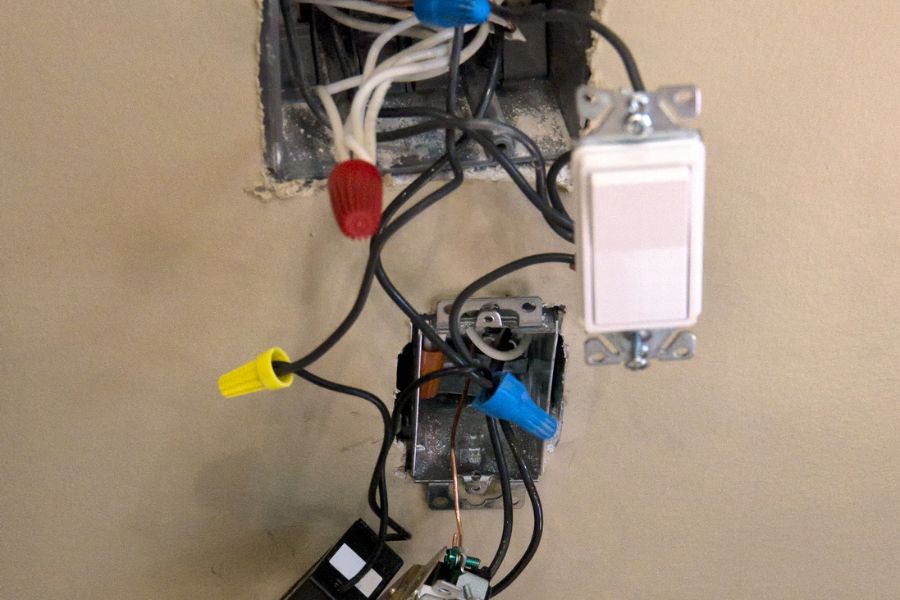
To repair or replace your electrical switches safely: turn off power at the circuit breaker, use a voltage tester, work in a well-lit area, wear insulated gloves, and avoid touching exposed wires. Tools needed include a flathead screwdriver, Phillips screwdriver, voltage tester, needle-nose pliers, and wire cutter/stripper. Steps: verify power is off, remove cover plate, unscrew mounting screws, disconnect old switch wires, connect new switch wires securely. Troubleshoot by checking the circuit breaker, ensuring wiring connections, and inspecting for faults. Consider upgrading to smart switches for remote access, energy monitoring, and better control. As you ensure safety and follow steps precisely, success is more likely.
Safety Precautions for Electrical Switch Repair
When repairing or replacing electrical switches, prioritize your safety by following necessary precautions to prevent potential hazards. Before starting any work, ensure that the power to the switch you are working on is turned off at the circuit breaker to avoid the risk of electric shock. It is crucial to use a voltage tester to double-check that there is no current running through the switch. Additionally, always work in a well-lit area to clearly see what you are doing and to avoid mistakes.
When handling the switch, make sure to wear insulated gloves to protect yourself from any residual electrical currents. Be cautious when removing the switch cover and the switch itself, as there may still be live wires connected. Avoid touching any exposed wires and use proper tools to safely disconnect and reconnect the switch.
Remember to follow manufacturer instructions and adhere to local electrical codes to guarantee a secure repair or replacement process. Your safety should always be the top priority when working with electrical switches.
Tools Needed for Switch Replacement
To efficiently replace an electrical switch, ensure you have the necessary tools at hand. The primary tools you will need for switch replacement include a flathead screwdriver, a Phillips screwdriver, a voltage tester, needle-nose pliers, and a wire cutter/stripper. The flathead screwdriver will help you remove the switch cover plate, while the Phillips screwdriver is essential for unscrewing the switch from the electrical box. A voltage tester is crucial to ensure the power is off before starting work to prevent electrical shocks. Needle-nose pliers are helpful for bending and shaping wires, and the wire cutter/stripper is necessary for preparing the wires for connection. Additionally, having a flashlight can be beneficial for better visibility in dimly lit areas. Ensure all tools are in good working condition before starting the switch replacement process to avoid any delays or safety hazards.
Steps to Remove and Replace a Switch
Begin by verifying that the power to the switch has been turned off before proceeding with the removal and replacement process. To remove and replace a switch, you will need a flathead screwdriver and possibly a voltage tester to ensure the power is off. Start by removing the switch cover plate using the screwdriver. Next, unscrew the switch mounting screws and gently pull the switch out of the electrical box.
Once the switch is out, take note of how the wires are connected to it. Typically, there will be two black wires connected to the switch. Loosen the terminal screws to disconnect the wires. Remember which wire goes where to reconnect them correctly to the new switch.
Now, take your new switch and connect the wires in the same manner as the old switch. Gently push the switch back into the electrical box and secure it with the mounting screws. Finally, replace the switch cover plate and turn the power back on to test the new switch.
Troubleshooting Common Switch Issues
If you encounter common issues with electrical switches, understanding how to troubleshoot them can help you resolve the problem efficiently. One common problem is a switch that doesn’t work at all. Start by checking if the circuit breaker is on and if the switch is receiving power. If the switch feels loose or wobbly, the issue may lie with the wiring connections. Ensure the wires are securely attached to the switch terminals. Another issue could be a switch that produces sparks when toggled. This is often caused by a loose connection or faulty wiring. Turn off the power and inspect the wiring to identify any damage. Dimming or flickering lights when using a switch can indicate a loose connection or a switch nearing the end of its lifespan. Tighten the connections and consider replacing the switch if problems persist. By troubleshooting these common switch issues, you can ensure your electrical system operates safely and efficiently.
Upgrading to Smart Switches for Efficiency
Consider upgrading your electrical switches to smart switches for improved efficiency in your home. Smart switches offer convenient features like remote access, scheduling, and energy monitoring. By replacing traditional switches with smart ones, you can control your lights and devices from anywhere using your smartphone or voice commands. This upgrade not only enhances the functionality of your home but also helps you save on energy costs.
Smart switches are easy to install and compatible with most existing wiring setups. They come in various styles to suit your preferences and can be integrated into smart home systems for seamless automation. With the ability to create custom schedules, you can ensure that your lights are only on when needed, reducing unnecessary energy consumption.
Additionally, smart switches provide insights into your energy usage, allowing you to identify areas where you can further optimize efficiency. Overall, upgrading to smart switches is a practical way to modernize your home and increase its energy efficiency.







